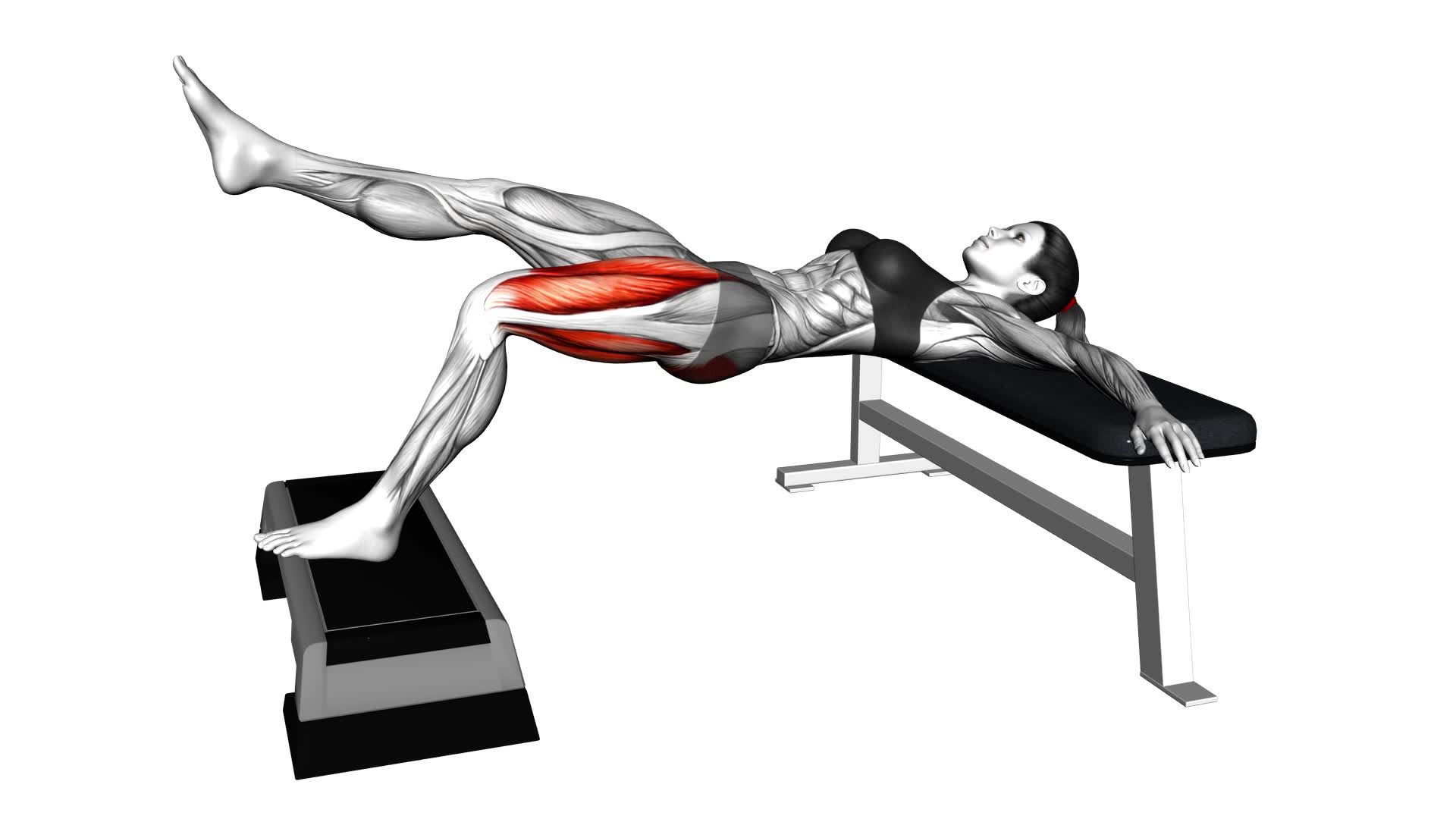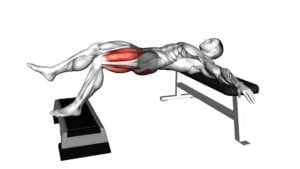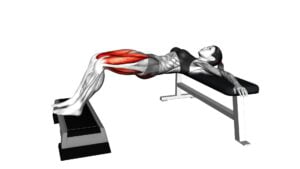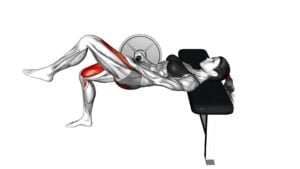Elevated Single Leg Hip Thrust (female) – Video Exercise Guide & Tips

Are you looking to strengthen your glutes and improve your lower body strength? Try the elevated single leg hip thrust! This exercise targets your glute muscles, helping you build a strong and toned booty.
Watch This Exercise Video
In this video exercise guide, we will show you the proper form and technique for the elevated single leg hip thrust, as well as provide tips and variations to keep challenging yourself.
Get ready to feel the burn and transform your lower body!
Key Takeaways
- The elevated single leg hip thrust targets and strengthens glute muscles effectively.
- It can be modified for different fitness levels and goals.
- Proper form and technique are important to maximize results and prevent injuries.
- Variations and progression options can be used to increase the challenge and target different areas of the glutes.
Benefits of the Elevated Single Leg Hip Thrust
One major benefit of the elevated single leg hip thrust is its ability to target and strengthen your glute muscles effectively. This exercise specifically focuses on the gluteus maximus, which is the largest muscle in your buttocks. By performing the elevated single leg hip thrust, you can increase the strength and size of your glute muscles, leading to improved overall lower body strength and stability.
Another benefit of this exercise is that it helps to correct muscle imbalances. Many people have weaker glute muscles compared to their quadriceps or hamstrings, which can lead to poor posture and increased risk of injury. The elevated single leg hip thrust helps to address this imbalance by isolating and activating the glutes, helping to improve muscle symmetry and overall function.
Additionally, the elevated single leg hip thrust can be modified to suit different fitness levels and goals. For beginners, using body weight or lighter resistance can be a great starting point. As you progress, you can increase the resistance by using dumbbells or a barbell placed across your hips. This exercise can also be modified by adjusting the height of the elevated surface, such as using a lower step or bench for a greater challenge.
Proper Form and Technique for the Exercise
To perform the elevated single leg hip thrust with proper form and technique, position yourself on an elevated surface, such as a bench or step, with one foot firmly planted on the ground. Here's how to execute the exercise correctly:
- Place the heel of your non-working leg on the elevated surface, with your knee bent at a 90-degree angle.
- Keep your working leg's foot flat on the ground, a comfortable distance away from the bench.
- Engage your core and glute muscles.
- Drive through your planted foot, lifting your hips off the ground and extending your working leg.
- Squeeze your glutes at the top of the movement and pause briefly.
- Lower your hips back down to the starting position in a controlled manner.
Proper form and technique are crucial for maximizing the benefits of the elevated single leg hip thrust.
However, if you're looking to add variety to your workouts, here are some hip thrust modifications and advanced variations to consider:
- Resistance band hip thrusts: Place a resistance band around your thighs, just above your knees, to increase the intensity and activation of your glute muscles.
- Barbell hip thrusts: Use a barbell across your hips instead of body weight to add resistance and challenge your strength.
- Single leg barbell hip thrusts: Perform the exercise with one leg elevated on a bench and a barbell across your hips, adding an extra balance and stability component.
Remember to start with proper form and gradually progress to more advanced variations to ensure safe and effective training.
Variation and Progression Options for Females
Explore different variations and progression options to challenge and strengthen your glute muscles during the elevated single leg hip thrust exercise.
To modify the elevated single leg hip thrust, you can start by performing the exercise on a lower surface, such as a step or a bench, instead of a higher surface. This will decrease the range of motion and make it easier to perform.
Another modification you can try is using both feet on the ground instead of elevating one leg. This will provide more stability and allow you to focus on building strength in both glute muscles simultaneously.
For more advanced single leg hip thrust variations, you can add resistance by using a barbell or dumbbells placed across your hips. This will increase the intensity and challenge your glute muscles even more.
Another option is to perform the exercise with your feet on a stability ball or a BOSU ball, which will require more stability and engage your core muscles as well.
Remember to always start with proper form and technique before progressing to more challenging variations. Take your time to master each modification before moving on to the next level.
Common Mistakes to Avoid During the Hip Thrust
Avoid these common mistakes when performing the hip thrust exercise to ensure proper form and maximize its effectiveness. To get the most out of your hip thrust technique and avoid potential injuries, pay attention to the following:
- Incorrect foot placement: Placing your feet too far away or too close to your glutes can affect the targeted muscles. Aim to position your feet around hip-width apart, with your toes pointing forward.
- Lack of core engagement: Neglecting to engage your core during the hip thrust can lead to compensations and reduce the effectiveness of the exercise. Remember to brace your core and maintain a neutral spine throughout the movement.
- Insufficient hip extension: Failing to achieve full hip extension at the top of the thrust can limit the activation of the glutes. Squeeze your glutes at the top and make sure your hips are fully extended.
Now that you know what mistakes to avoid, let's move on to the next section where we'll discuss tips for getting the most out of your hip thrust workout.
Tips for Getting the Most Out of Your Hip Thrust Workout
To maximize the effectiveness of your hip thrust workout and achieve optimal results, focus on implementing these tips.
First and foremost, understand the benefits of hip thrust exercises. Hip thrusts primarily target the glute muscles, helping to build strength, power, and shape in that area. They also engage the hamstrings and core muscles, making it a great compound exercise.
To get the most out of your hip thrust workout, consider pairing it with other exercises that complement its benefits. For example, including squats in your routine can further enhance glute and leg strength. Lunges are another excellent choice as they target multiple muscles, including the glutes, quads, and hamstrings.
When performing hip thrusts, it's crucial to maintain proper form. Start by positioning your upper back against a bench or elevated surface, with your feet flat on the ground and knees bent. As you lift your hips, squeeze your glutes and hold the position for a second or two before lowering back down.
To challenge yourself further, you can add resistance by using a barbell, resistance bands, or weights. Gradually increasing the weight or resistance over time will help you continue progressing and getting stronger.
Remember to always listen to your body and adjust the intensity and difficulty of your hip thrust workout as needed.
With consistency and these tips in mind, you'll be on your way to maximizing the benefits of hip thrust exercises and achieving your fitness goals.
Frequently Asked Questions
Can Men Also Perform the Elevated Single Leg Hip Thrust Exercise?
Yes, men can definitely perform the elevated single leg hip thrust exercise. This exercise offers several benefits for men, including improved glute strength, hip stability, and overall lower body power.
It's a great way to target the glute muscles and strengthen the posterior chain. Additionally, there are variations available for different fitness levels, allowing individuals to progress or modify the exercise as needed.
How Often Should I Incorporate the Elevated Single Leg Hip Thrust Into My Workout Routine?
To get the most out of your workout routine, it's important to know how often you should include the elevated single leg hip thrust.
Incorporating this exercise into your training program offers numerous benefits. It helps strengthen your glutes, hamstrings, and core, improving overall lower body strength and stability.
To see results, aim to do this exercise 2-3 times a week, allowing for rest days in between.
Remember to start with a weight that challenges you but allows for proper form.
Are There Any Modifications or Alternatives for Individuals With Knee or Hip Joint Issues?
If you have knee or hip joint issues, there are modifications and alternative exercises you can try.
For knee issues, you can perform a glute bridge instead of the elevated single leg hip thrust. This exercise is less stressful on the knees.
If you have hip joint issues, you can try the clamshell exercise or side-lying leg lifts to target your glutes without putting too much strain on your hips.
Always listen to your body and consult with a professional if needed.
What Muscles Does the Elevated Single Leg Hip Thrust Primarily Target?
The elevated single leg hip thrust primarily targets your glutes, hamstrings, and core muscles. By doing this exercise, you can strengthen and tone these muscle groups, improve hip stability and mobility, and enhance overall lower body strength.
The elevated position increases the intensity of the exercise, making it more challenging and effective. Incorporating this exercise into your routine can help you achieve a stronger and more sculpted lower body.
Can the Elevated Single Leg Hip Thrust Exercise Help Improve My Running or Cycling Performance?
The elevated single leg hip thrust exercise can be beneficial for improving your running or cycling performance. By targeting the glutes, hamstrings, and core muscles, this exercise helps to strengthen these areas, which are important for generating power and stability during running and cycling.
Additionally, the hip thrust can improve hip extension, which is essential for efficient movement and increasing endurance. Incorporating this exercise into your training routine can contribute to improved overall performance.
Conclusion
In conclusion, the elevated single leg hip thrust is a highly effective exercise for females to strengthen their glutes and improve lower body strength.
By maintaining proper form and technique, varying and progressing the exercise, and avoiding common mistakes, women can maximize the benefits of this workout.
Incorporating these tips into your hip thrust routine will ensure that you get the most out of each session and see results.

Author
Years ago, the spark of my life’s passion ignited in my mind the moment I stepped into the local gym for the first time. The inaugural bead of perspiration, the initial endeavor, the very first surge of endorphins, and a sense of pride that washed over me post-workout marked the beginning of my deep-seated interest in strength sports, fitness, and sports nutrition. This very curiosity blossomed rapidly into a profound fascination, propelling me to earn a Master’s degree in Physical Education from the Academy of Physical Education in Krakow, followed by a Sports Manager diploma from the Jagiellonian University. My journey of growth led me to gain more specialized qualifications, such as being a certified personal trainer with a focus on sports dietetics, a lifeguard, and an instructor for wellness and corrective gymnastics. Theoretical knowledge paired seamlessly with practical experience, reinforcing my belief that the transformation of individuals under my guidance was also a reflection of my personal growth. This belief holds true even today. Each day, I strive to push the boundaries and explore new realms. These realms gently elevate me to greater heights. The unique combination of passion for my field and the continuous quest for growth fuels my drive to break new ground.







